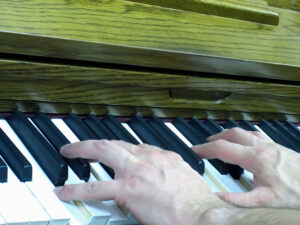This article is for piano teachers looking for ways to introduce improvisation into their students’ lessons and make the experience fun and successful.

This week, I was very fortunate to be able to attend a program on the “Art of Improvisation” conducted by Jeffrey Chappell—a true expert on the subject. As a piano teacher who also teaches popular and sacred styles, improvisation is an element I personally incorporate into lessons, but after the presentation, I was very inspired to try some of the new games and techniques discussed.
One of the most important concepts discussed during the lecture was the fact that improvisation is what we do constantly—it’s personalization and each person’s own individual experience. “No one will improvise what you improvise.”
Wow, right? Now how does this tie into music study?
Many different musicians ranging from students to professionals are intimidated by even the word “Improvisation”. I really like the idea of praising the individualism of improvisation, and with this core philosophy, we as teachers can help our students understand and embrace the art they create.
So how do we get our students improvising?
I’ll share three of the takeaway ideas from Jeffrey Chappell’s lecture and how I would approach some of the lessons, but if you are a teacher and interested in his much more in depth, expert, and comprehensive courses, check out musiceverybody.com.
1. You as a teacher can establish a three or four chord progression for a student to play along with in free form. You want to provide some guidance as to key area (i.e. “just use black keys” or “stay within a C 5 finger scale”), but let it be an open experience. If the student is shy or hesitant and does not know what to play, imitation can be used as a great tool to get the student into the exercise. With parameters established, the resulting sound is nice, and the student will recognize this as well.
2. The next idea I really loved was copying and merging a consistent rhythmic pattern established by the teacher pretty freely on any notes of the piano. The teacher demonstrates a pattern, and both the teacher and student keep the same rhythm between them, but can use any notes to do so. I can’t emphasize how cool the result sounded when I heard it demonstrated, and as a side note, this revealed to me that most improvisations will sound interesting if just one constant parameter is established—whether it be rhythm, harmony, etc.
3. Another basis for improvisation that was very interesting to me was improvising around an emotion or mood. With a student, you can establish what emotion you want to convey and demonstrate it through collaborative improvisation. As a teacher, you would provide direction and support for this by creating concurring chord progressions, tempos, etc, but there is a lot of freedom in what is created between the teacher and student on this idea. As a fun way to get others in the household involved, ask a parent to guess the emotion being demonstrated!
Teaching Piano Students
As a closing thought, I want to share the key to making your students feel great about improvising that Jeffrey Chappell reiterated throughout the lecture: ask the student if it was easy and if it was fun. There is a lot of power in positive reinforcement, and if your students feel good about their creativity and the music they can make, they will continue to enjoy improvising.
